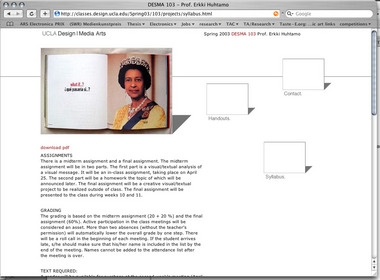DESCRIPTION
In contemporary culture, visual images are everywhere in all imaginable forms. They serve all kinds of goals. Often they are claimed to have become more important than text, which used to be the unquestionable basis of culture. To cope with this complex visual environment we need "tools" that will help us to make sense of it. We need to be able to read the images and understand how they interrelate with each other, merge, and communicate meanings to different viewers. We need to see beyond their surface, to peek at what lies behind it (if anything). At the same time such "tools" will also help us create our own images by making us more aware of their
"nature", their cultural roles and their ways of communicating meanings. By introducing and applying ideas from theories of visual culture, particularly visual semiotics, this course aims at providing a deeper understanding of images in contemporary culture. Many examples, ranging from advertising to film, multimedia and the Web will be discussed. There will be well-known
quest speakers talking about their work on the field of visual communication. The main goals are to teach the participants new ways of seeing/reading their visual environment(s), and to encourage them to apply these skills to their own work with images.
ASSIGNMENTS
There is a midterm assignment and a final assignment. The midterm assignment will be in two parts. The first part is a visual/textual analysis of a visual message. It will be an in-class assignment, taking place on April 25. The second part will be a homework the topic of which will be announced later. The final assignment will be a creative visual/textual project to be realized outside of class. The final assignment will be presented to the class during weeks 10 and 11.
GRADING
The grading is based on the midterm assignment (20 + 20 %) and the final assignment (60%). Active participation in the class meetings will be considered an asset. More than two absences (without the teacher's permission) will automatically lower the overall grade by one step. There
will be a roll call in the beginning of each meeting. If the student arrives late, s/he should make sure that his/her name is included in the list by the end of the meeting. Names cannot be added to the attendance list after the meeting is over.
TEXT
REQUIRED:
A reader will be available for purchase at the second week's meeting (April 11). Please bring money with you (estimated cost: under 20 dollars). A copy of the reader will be on reserve at The Arts Library.
RECOMMENDED:
The following books are recommended as additional reading. Copies will be on reserve at the Arts Library.
- Aumont, Jacques: The Image. London: BFI Publishing, 1997.
- Berger, John: Ways of Seeing. London: BBC and Penguin Books, 1972.
- Bolter, Jay David and Grusin, Richard: Remediation. Cambridge, Mass.: The MIT Press, 1998.
- Lupton, Ellen and Miller, J. Abbott: Design Writing Research. Writing on Graphic Design. New York: Princeton Architectural Press.
- Mitchell, William J.: The Reconfigured Eye. Visual Truth in the Post-Photographic Era. Cambridge, Mass.: The MIT Press, 1992.
- Sturken, Marita and Cartwright, Lisa: Practices of Looking. An Introduction to Visual Culture. Oxford: Oxford University Press, 2001.
- Walker, John A. & Chaplin, Sarah: Visual Culture: an introduction. Manchester & New York: Manchester University Press, 1997.
- Williamson, Judith: Decoding Advertisements. London & New York: Marion Boyars, 1978.
- Visual Culture. Edited by Chris Jencks. London and New York: Routledge, 1995.
